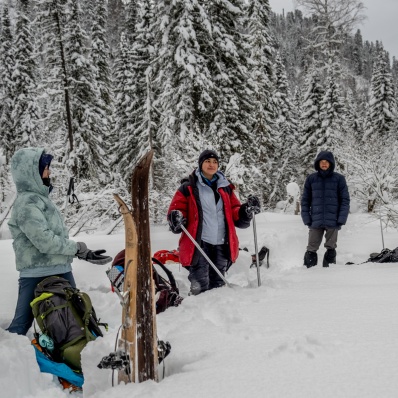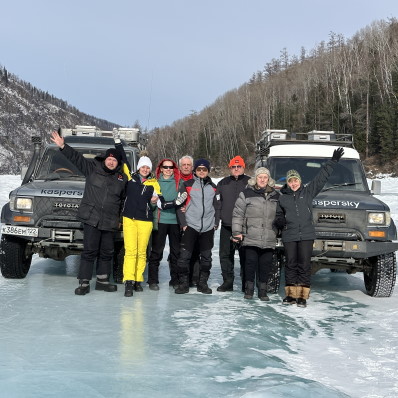Отзыв о путешествии Тыва-Укок. август-сентябрь, 2009/ Report about Altai Tour
I open my tent and and look at the small tents of my fellow-travelers and the big kitchentent, in which I can hear promising noises. We peel out of our warm sleeping bags — there were minus degrees in the night — and go down to the river with icecold milky white water from the glacier to have a cat's lick. We are camping at the Akalacha river, a wide river, which meanders through the Ukok-Plateau. The bend of the river here is bordered by a huge eroded rock, so that there exists a natural amphitheatre, which is called Bertek basin. When I look out at the other side of my tent I see in about 20 — 30 km distance the snowcovered summits of the Tabuin Bogda Ola, one of the 3 main glaciers of the Altai mountains, now in shining sunlight.This Ukok-Plateau is of historical importance. It is world heritage, but only known by archaeologists and not mentioned in the normal English or German guidebooks. In this large mountain tundra settled 400 B.C. the Scythians- at the same time like the Celts in Europe. They left many tomb mounds.In 1993 a tomb was found, in which was the body of a noble young woman, preserved by embalming and the permafrost, the «princess of the Scythians»; it was a scientific sensation, comparable with «the Ötzi».In a distance of about 5 km there are rocks with well kept petroglyphes of ibex, deer,camels and hunters with bow and arrow in artistic manner. It is a precious testimony of history in its original place without tickets — for us an impressive experience.You walk over bunches of tundragrass, moss, lichen and low vegetation. The beginning of autumn makes the hills shine in different red colours.The soft hills are covered with white and blue gentian, edelweiss and yellow alpine poppies.Under rocks you see the entrances of marmots and sousliks. The animals are shy, mostly you see them by driving. In the sky are flying steppe eagles. The 10 day trip started in Barnaul, a city with about 700000 inhabitants, about 250 km south of Nowosibirsk. We drove along the Tschuisky Trakt — an old trading route to Mongolia- along the Katun and Tschuja river. After 2 days we reached Kosch Agatsch. From here the drive to the Hindiktik lake is only possible with offroad vehicles. The drive is a pleasure for offroad fans. The 4 wheel minibuses move over rocks, dig through deep mudholes, cross rivers with steep embankments and creep in riverbeds with water. We cross a pass with 2600 m with a cairn,decorated with white ribbons: we are in the Tuwa region. The Tuwa nomads believe in a buddhistic shamanistic religion. They live here in summer with their big herds of cattle, sheep, goats or yaks.We felt good in this Russian group, existing of 10 clients and the team with drivers and cook. One of the two guides is also alpine guide and university teacher in tourism and speaks German very well; a combination, which was perfect for this tour and especially for us. His knowledge about history and nature of this region is impressive.We have been very satisfied with the organisation. The equipment — kitchen tent, sleeping tents, sleeping bags etc. — is international standard. There was even a sauna tent. Our impressions were various and intensive, not only concerning the nature experience, but also in living together with our Russian fellow travellers.Highly recommendable!
Peter and Erika, Germany, August 09



 Альпинизм
Альпинизм Джипинг
Джипинг Лыжные туры
Лыжные туры Рафтинг
Рафтинг Трекинг
Трекинг

